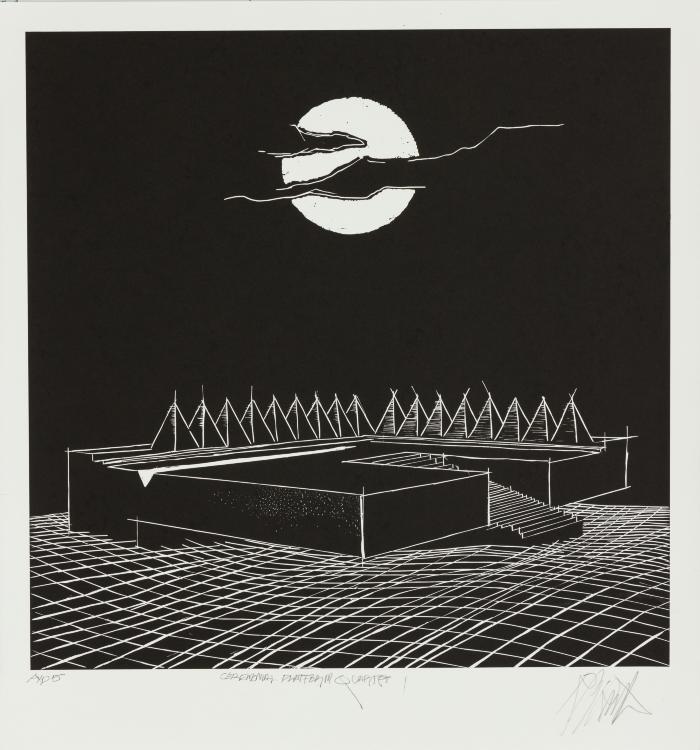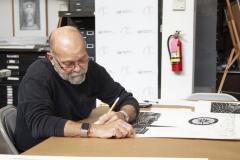
Ceremonial Platform Quartet 1
Robert Roesch
- 2016
- Offset Lithograph
- Image/sheet: 23 x 23"
- 20 prints in this edition
About the Print
From the Artist
For the past 50 years I have produced work in the Postmodernist tradition, attempting to create beautiful shapes and a movement that sends the mind flying. Not long ago, an instant of clarity came over me, and I found myself enveloped in the Brutalist movement. The architectural structures I was looking at were calling to me, asking, “How can these powerful images become a part of me, and by extension, a part of my work?”
I found myself making drawings and building 3D-printed models of places that seemed to me to be safe, quiet, and protected from the ravages of the world we live in. Eyes Eastbound, the title of the 13th Cairo Biennale, strikes this strong image in my mind—an image of all humanity aligned facing east and thereby sharing a commonality and unity. Perhaps my platforms could be seen as starting points, helping us to reach our inner humanity and then, facing east, find common ground.
Brutalist thinking came out of the destruction of war, and holds a strong sense of form and function. There was a need to rebuild cities destroyed as a result of the last world war. What better material than poured concrete, and what greater inspiration than citizens working toward one common goal. To me, Brutalist thinking is an example of the resiliency of human beings. An instance of our desire to make things right, our desire to survive on this planet.
My new work can be identified by heavy, poured concrete slabs becoming floors and walls, and polished stainless steel or polychromed material turned into slender spires. The spires are a form I’ve used for years in my work containing a deep and endless meaning. They are much like trees, and leave behind the mark of man’s intervention on nature. My spires are architectural icons; they bring rest to my fragmented soul. Stairways, leading to no place in particular, excite me. They give my artwork scale, contrasting insignificant humans coping with the grandness of the structure they occupy. This structure is so directly imposing that the everydayness of our lives disappears into the structure that consumes us.
—From https://noyesmuseum.org/robert-roesch, accessed 7-5-2021
About the Artist
Sculptor and professor Robert Roesch was born in New York City. He earned a BA from the State University of New York, Farmingdale, and BFA from Pratt Institute, New York City.
He has received numerous grants, including a Fulbright Specialist Award in Japan. He represented the United States in the 2009 Baku Bienniale, Azerbaijan, and exhibited at the Cairo Biennale, Egypt, in 2007 and 2009.
Roesch’s work is in museum collections nationally and Internationally, including the Philadelphia Museum of Art; Paper Museum, Tokyo; Kyoto Institute of Technology Museum, Japan; Bibliotheca Alexandrina, Alexandria, Egypt; International Museum of Art & Science, McAllen, TX; and Glasmuseet Ebeltoft, Denmark. He has completed 20 major public art projects in the United States including the gateway to the city of Wichita Kansas and the entrance to Texas A&M University, Corpus Christi.
Roesch and his wife, artist Suzanne Horvitz, were cultural advisors to the United States embassies in Azerbaijan, Egypt, Syria, Argentina, Ecuador, and Myanmar. Their collaborative sculpture Transduction is a permanent installation at Grounds for Sculpture, Hamilton Township, NJ.
Roesch is chair of sculpture at the Pennsylvania Academy of the Fine Arts, Philadelphia, where he teaches a sculpture seminar on digital imaging. He is a member of the Philadelphia Art Commission. Roesch splits his time between Philadelphia and his studio in the New Jersey Pinelands near Hammonton.
—From Brandywine Workshop and Archives records
Curriculum Connections
Suggested Topics for Algebra I and Geometry
Algebra I:
The resources provided can be used early on in an Algebra class to help students think in multiple dimen- sions. The artworks can be used to demonstrate illusions intended as a design element or to help students imagine space constructed or deconstructed from forms or shapes within a space. The ability to visualize concepts through art can make advanced math more accessible to students early on.
Geometry:
Some may want to use images in the Artura.org library to explore more complex uses of advanced math to create the illusions of space and solve spatial dynamic issues for three-dimensional works such as stand-alone sculpture and site-specific, public artworks. The laying of bricks or ceramic tiles is a skilled craft that can involve creativity and innovation in bricks or tiles are set and many available options in color, design, and texture are used. Sculptors such as Melvin Edwards, Richard Hunt, and John T. Scott have consistently used higher math concepts in the creation of large scale, space-defining public art.
Questions to Consider
- What are the different considerations between symmetry and asymmetry in relation to designing a structure or composing a work of art?
- What roles can rhythm, repetition, pattern, proportion, and scale play in an architect’s design and construction process? What roles can they plan in making a work of art?
- Other than the design of buildings, where else does one observe the use of the right angle in a creative way and for what purposes?
